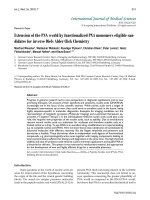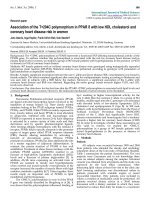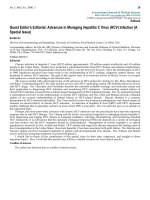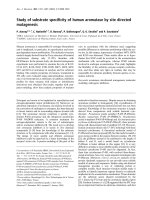Báo cáo y học: "Study of the early steps of the Hepatitis B Virus life cycle"
Bạn đang xem bản rút gọn của tài liệu. Xem và tải ngay bản đầy đủ của tài liệu tại đây (204.95 KB, 13 trang )
Int. J. Med. Sci. 2004 1(1): 21-33
21
International Journal of Medical Sciences
ISSN 1449-1907 www.medsci.org 2004 1(1):21-33
©2004 Ivyspring International Publisher. All rights reserved
Study of the early steps of the Hepatitis B Virus life cycle
Research paper
Received: 2004.2.02
Accepted: 2004.3.03
Published:2004.3.10
Xuanyong Lu, Timothy Block
Jefferson Center for Biomedical Research and Agricultural Medicine, Department of
Biochemistry and Molecular Pharmacology, Thomas Jefferson University, Philadelphia,
USA
A
A
b
b
s
s
t
t
r
r
a
a
c
c
t
t
Hepatitis B virus (HBV) is a human pathogen, causing the serious liver disease.
Despite considerable advances in the understanding of the natural history of
HBV disease, most of the early steps in the virus life cycle remain unclear. Virus
attachment to permissive cells, fusion and penetration through cell membranes
and subsequent genome release, are largely a mystery. Current knowledge on
the early steps of HBV life cycle has mostly come from molecular cloning,
expression of individual genes and studies of the infection of duck hepatitis B
virus (DHBV) with duck primary duck hepatocytes. However, considering of the
difference of the surface protein of HBV and DHBV both in the composition and
sequence, the degree to which information from DHBV applies to human HBV
attachment and entry may be limited. A major obstacle to the study HBV
infection is the lack of a reliable and sensitive in vitro infection system. We have
found that the digestion of HBV and woodchuck hepatitis virus (WHBV) by
protease V8 led to the infection of HepG2 cell, a cell line generally is refractory
for their infection [Lu et al. J Virol. 1996. 70. 2277-2285. Lu et al. Virus
Research. 2001. 73(1): 27-4]. Further studies showed that a serine protease
inhibitor Kazal (SPIK) was over expressed in the HepG2 cells. Therefore, it is
possible that to silence the over expressed SPIK and thus to reinstate the activity
of indispensable cellular proteases can result in the restoration of the
susceptibility of HepG2 cells for HBV infection. The establishing a stable cell line
for study of the early steps of HBV life cycle by silencing of SPIK is discussed.
K
K
e
e
y
y
w
w
o
o
r
r
d
d
s
s
Hepatitis B virus, Fusion, Serine protease inhibitor, Receptor, Attachment.
A
A
u
u
t
t
h
h
o
o
r
r
b
b
i
i
o
o
g
g
r
r
a
a
p
p
h
h
y
y
Xuanyong Lu Ph. D is an Assistant Professor of Department of Biochemistry and
Molecular Pharmacology, Thomas Jefferson University, Philadelphia, USA. His current
researches investigate the entry of hepatitis B virus, particularly in the viral fusion and
proteolysis. His researches also include the efforts to establish a cell line susceptible for
HBV infection by silencing over expressed SPIK gene in the hepatoma cell lines.
Timothy M Block Ph. D is a Professor, director of Jefferson Center for Biomedical
Research and Agricultural Medicine, Thomas Jefferson University, USA. His current
researches include the role of glycan in the HBV infection, assembly and secretion, the
anti-HBV drug exploration and development and the latent of Herpes simple virus.
C
C
o
o
r
r
r
r
e
e
s
s
p
p
o
o
n
n
d
d
i
i
n
n
g
g
a
a
d
d
d
d
r
r
e
e
s
s
s
s
Dr. Xuanyong Lu, Department of Biochemistry and Molecular Pharmacology, Thomas
Jefferson University, 700 East Butler Ave, Doylestown, PA, 18901. Telephone: 215-489-
4906. Fax: 215-489-4920. E-mail:
Int. J. Med. Sci. 2004 1(1): 21-33
22
1.
Introduction
The Hepatitis B virus (HBV), which belongs to the hepadnavirus family, is a small circular DNA
virus containing a nucleocapsid and an envelope. HBV nucleocapsid contains a relatively small and
incompletely double stranded 3.2 Kb DNA genome, viral polymerase and core protein. Its envelope is
composed of viral surface proteins enclosed by a lipid membrane from host cells [1, 2]. In the serum of
infected patients, there are both mature virion with viral DNA and subviral particles without viral DNA
[3, 4]. Sub viral particles are overwhelmingly in excess to infectious particles, which is the majority of
the two types [3, 4]
The life cycle of HBV is believed to begin when the virus attaches to the host cell membrane via
its envelope proteins. Then, the viral membrane fuses with the cell membrane and the viral genome is
released into the cells [5, 6] After the viral genome reaches the nucleus, the viral polymerase converts
the partial double stranded DNA (dsDNA) genome into covalently closed circle DNA (cccDNA). The
cccDNA is believed to be the template for further propagation of pre-genomic RNA, which directs the
synthesis of viral DNA and mRNA that encode all the viral proteins [2, 7, 8] HBV core particles are
assembled in the cytosol following the encapsidation of pre-genomic RNA, which is then degraded
during the reverse transcription of pre-genomic RNA into a complementary strand of DNA [9]. HBV
surface proteins are initially synthesized and polymerized in the rough endoplasmic reticulum (RER).
These proteins are transported to the post ER and pre-Golgi compartments where budding of the
nucleocapsid follows [10]. The assembled HBV virion and sub-viral particles are transported to the
Golgi for further modification of its glycans in the surface proteins, and then are secreted out of the host
cell to finish the life cycle. HBV replication and viral protein synthesis in the infected cells are fairly
well elucidated. However, the early steps of HBV infection including of the penetration of virus and
release of its genome into host cells is uncertain.
In general, the early step of virus infection in which the virus enters the cell can be divided into
three stages: attachment, fusion, and entry. Enveloped viruses usually entry by an attachment to the
host cells, which usually is via the interaction of viral surface protein with the specific receptor on the
cell membrane [11]. However, the attachment itself does not necessarily result in viral entry. The fusion
of a viral envelope and cell membrane and the following viral genome release finally trigger the viral
infection [12, 13]. The viral fusion occurs by one of at least two known mechanisms. The first requires
a fusion of the viral envelope with the plasma membrane, leading to the release of the viral
nucleocapsid. HIV is an example of a virus that uses this type of mechanism to enter [12]. In the
second mechanism, an endosomal compartment first takes up the attached virus. Later, the viral genome
is released from this endosomal compartment into the cytoplasm by a process that may or may not
depend upon a lowering of the pH to activate a virus-mediated fusogenic activity. In some virus/cell
systems, such as those involving influenza virus [14] or paramyxoviruses [11, 13] exogenously adding
protease generates infective virions from otherwise non-infective ones. The reason is that the
proteolysis exposes the viral fusion sequence. The un-coating and the genome release occur instantly
after virus fusion. The following transport of the viral genome to nucleus and the start of the virus
replication finally complete the early steps of virus life cycle.
2.
The attachment of HBV
A major limitation to study HBV early steps of life cycle is lack of an in vitro infection system.
Although HBV is considered highly efficient in establishing infection in people following parenteral
exposure, tissue culture cells are curiously refractory for HBV infection [5, 15, 16, 17]. Although there
is a growing body of data, recently most of the published information about the early stages of
hepadnavirus infection is derived from duck hepatitis B virus (DHBV), since robust DHBV infectable
tissue culture systems do exist. There are, however, significant differences between the duck and human
hepatitis viruses. For example, and perhaps of greatest relevance, human HBV envelope polypeptides,
the likely mediators of entry, are N-glycosylated, whereas DHBV envelope polyepotides are not. Thus,
the degree to which information from DHBV applies to human HBV attachment and entry may be
limited.
The HBV surface protein antigens (HBsAg) are comprised of three carboxyl-co-terminal HBs
proteins termed large (LHBs), middle (MHBs) and small (SHBs, also called major) protein [3, 4]. LHBs
and MHBs also share the highly hydrophobic, repetitive, membrane-spanning S domain. In addition,
Int. J. Med. Sci. 2004 1(1): 21-33
23
MHBs has a 55 amino acid region called preS2, LHBs has an additional 109-120 amino acid long
region called preS1 (dependent on the viral subtype) in their N-terminus (figure 1 A) [4]. Although
HBV surface proteins must certainly mediate early steps in the virus life cycle, the precise role for each
glycoprotein in the entry and egress of the virus is controversial. We will thus discuss this now.
LHBs is essential for attachment has been generally accepted. The studies of hepadnavirus in cell
culture, especially with explanted human or duck primary liver cells, strongly suggest that LHBs is
directly involved in the viral attachment [18, 19, 20]. The putative attachment site of HBV located in
the preS1 was first reported by Neurath and his colleagues using anti-preS1 antibody [21, 22]. They
found that the antibody against peptide corresponding to the HBV preS1 domain was virus-neutralizing
and protective [21]. In 1989, Pontisso and his colleagues, using the membranes of surgically obtained
human liver as a target, further confirmed the role of LHBs in the HBV attachment [23]. Recently, the
attachment site of LHBs was functionally narrowed down to the amino acids 21–47 of preS1 by
employing synthetic peptides. The results suggest that this binding site was not only required but also
sufficient to attach specifically HepG2 cells (Figure 1 B) [24, 25]. Moreover, the antibody with this site
has neutralized the HBV infection in Chimpanzee [19, 21]. It is interesting that, by mutagenesis studies
and single cell attachment analysis, Paran and his colleagues found that the QLDPAF sequence within
this preS1 region was crucial for cell attachment [25]. Further evidence to support this hypothesis is that
this sequence is also found in the other virus and bacterial functioning as an adhesion or attachment
determinant [25]. This suggests that the QLDPAF sequence may have a more general role in viral
infection.
There are differing reports about the role of MHBs in the generation of HBV in the transfected
cells and in mediating HBV infection [8, 26]. MHBs seem to be absent in certain HBV variants from
chronically infected patients [27, 28], suggesting a non essential function in the viral infection. On the
other hand, misfolded MHBs seems to be able to interfere with the assembly of HBV virions in the
persistently producing virus cell line HepG2.215 [29, 30]. Anti-preS2 antibody (that recognizes MHBs)
can block HBV infection of primary human liver cell in vitro [31, 32] and chimpanzee liver cells in vivo
[33] suggesting that MHBs are probably also involved in viral entry. HBV preS2 can specifically bind
the poly-human albumin in vitro [34, 32, 35] and the mono human albumin in vivo [36, 37], more
investigation is needed to determine whether this binding capability is involved in the viral attachment.
SHBs, the most abundant viral glycoprotein, certainly has a role in virus secretion [24]. Its role in
virus uptake is supported by the studies of Leenders and his colleagues [38]. Using recombinant HBs
protein, they have performed binding studies with adult human hepatocytes, rat hepatocytes, human
fibroblasts, human peripheral blood mononuclear cells and plasma membranes derived from these cell
types. The results suggest that SHBs was able to bind specifically to human hepatocytes, human
fibroblasts and human blood mononuclear cells but not the rat hepatocytes. This binding could be
inhibited by recombinant HBs but not by the recombinant LHBs. The binding of SHBs with human
hepatocytes was further supported by the observation from Bruin et al [39]. They have found that the
particles only composed by SHBs can bind the human hepatocyte plasma membrane and this binding
resulted in the internalization of the gold labeled sub viral particles [25].
However, despite the literature about HBV surface proteins, determination of which of the proteins
is centrally responsible for HBV attachment and entry is elusive. Recently, synthetic beads conjugated
to viral proteins were used to quantitatively measure virus–cell attachment, at the level of single cell
resolution, by light microscopy [25]. In addition to attachment, entry of the HBV–protein conjugated
beads into the cells can be easily detected by scanning and transmission electron microscopy. It was
found that the beads conjugated with the recombinant preS1 protein containing the prominent QLDPAF
motif, but lacking the small HBsAg regions, show efficiently attach to cells. Interestingly, beads
conjugated with particles containing the whole repertoire of the surface proteins were twice as active in
attachment, compared to preS1 alone. Thus, it appears that it is possible HBV uptake involves multiple
attachment sties [17].
3. The cell receptor for HBV attachment.
It is also unclear as to the identity of the cellular macromolecules that are responsible for virus
attachment. Since HBV is highly infectious, in vivo, the relative refractoriness of liver cells, grown in
culture, has been something of a puzzle. The Studies duck hepatitis B virus (DHBV) infection with
primary duck hepatocytes have been particularly revealing. In 1994, then in 1995, Kuroki et al. reported
Int. J. Med. Sci. 2004 1(1): 21-33
24
that a glycoprotein in duck hepatocytes with the molecular weight 180 Kilo Dalton, called gp180, can
be co-precipitated with DHBV [40, 41]. Moreover, the interaction of gp180 and DHBV can be blocked
by monoclonal anti duck large protein antibodies. Subsequent cDNA cloning revealed the binding
protein to be a carboxypeptidase H-like molecule, now classified as duck carboxypeptidase D (DCPD).
Li and Tong have confirmed those [42, 43] and further demonstrated the carboxypeptidase D, a protease
existing in the avian hepatocyte, exiting in the mammalian hepatocytes either. The protease function of
carboxypeptidase D during the DHBV infection is unclear. The DHBV attachment receptor is a
protease implies that hepadnavirus infection probably requires proteolysis. This will be discussed later.
The study to identify the receptors for human HBV LHBs has been less successful. Despite the
fact that the specific preS1 domain for attachment of the LHBs to human liver cells and/or cell lines has
been repeatedly verified, the cellular protein that is responsible for this binding has not been found yet.
The limited availability of primary human tissue almost certainly hampers progress. Research has thus
relied heavily upon human hepatoma cell lines [44]. Using a synthesized peptide with the sequence of
HBV putative attachment site in preS1, Falco et al. have isolated a membrane protein called Hep-BP
from HepG2 cells, which can specifically bind HBV preS1 peptide. Furthermore, they found that after
the transfection of corresponding cDNA of Hep-BP into HepG2 cells, the virus binding capacity
increased by 2 orders of magnitude compared with untransfected cells. Chinese hamster ovary cells,
which normally do not bind to HBV, acquired susceptibility to HBV binding after transfection [45]. The
sequence analysis suggests this protein is highly homologous with the squamous cell carcinoma
(SCCA1), a serine protease inhibitor of ovalbumin family that has been used as a tumor marker for
diagnosis of SCC [46]. However, the lack of the tissue specificity and low level expression in the liver
cells reduce the possibility of it as a relevant receptor of HBV infection. It is worthy that Hep-BP is a
serine protease inhibitor and is over-expressed in the cancer cells [47]. The over-expression of another
serine protease inhibitor kazal type (SPIK) in the HepG2 and Huh 7 cells was also observed by us. The
possible role of this protease inhibitor in the HBV infection will be discussed later.
Using human hepatoma cell line or the membrane of human liver cells, the protein that bind HBV
MHBs or SHBs has been reported by several groups. In 1989, Potisso et al. reported that human liver
plasma membranes contain receptors for MHBs via associated with polymerized human serum albumin
[32]. Subsequently, Buine et al identified human liver endonexin II (EII) as a specific SHBs binding
protein [48]. A sialoglycoprotein was also reported as a receptor for SHBs binding in the uptake of
HBV [49, 50]. However, it is noted that no direct evidence to show that the interaction of HBV with
those receptors could result in the real infection. Therefore, the full understand of the HBV attachment
and it receptors perhaps could only be achieved after a susceptible cell line has been established.
4.
The HBV fusion and proteolysis
The attachment of HBV surface protein to the host cell is essential for HBV entry. However,
attachment alone is not sufficient for viral infection. The fusion of viral protein and cell membrane
allows the release of the viral genome into cytosol. Attachment and fusion are two distinct events.
Attachment usually is receptor mediated, and therefore, is highly cell specific. In contrast, viral fusion is
dependent on a specific domain within the viral surface protein, known as the "fusion motif,” which is
normally composed of a series of hydrophobic amino acids [51, 52, 53, 54] and is independent of
specific cell receptors and thus relatively less cell specific. Attachment possibly occurs at a low
temperature of 4° C. However, fusion requires a temperature of at least 20° C.
In 1993, we reported that HBV has a conservative region in the N-terminus of its S domain, which
encloses a hydrophobic sequence with 13 amino acids [51]. This sequence has all the characteristics of
fusion motif of other human viruses such as paramyxoviruses and retroviruses including of HIV, RSV
and influenza virus [5]. More important, this region includes a core hydrophobic sequence: FLG-LL-
AG, which is supposed to trigger the viral–cell fusion [55, 56]. Notably, this sequence is conserved in
all the hepadnavirus [5, 6]. The fusogenesis of this sequence was confirmed by Rodriguez-Crespo et al.
Using the synthesized peptides containing this region of HBV and woodchuck hepatitis virus (WHV),
they have demonstrated that these peptides can induce the fusion of bio-membranes, liposome leakage
and haemolytic activity in vitro [57, 58]. We also have found that the peptides containing this sequence
can trigger the syncytia of HepG2 cell from without (unpublished evidence). It is noteworthy that pre-
digestion of HBV with a bacterial protease V8 allowed the HBV and WHV entry into the unsusceptible
cell line such as HepG2 to initiate the infection [5, 6]. The reason that V8 protease treatment induces
Int. J. Med. Sci. 2004 1(1): 21-33
25
viral infectivity is not clear. However, V8 protease cleaves at a proteolytic sensitive region called
“PEST region” that is just adjacent to the putative fusogenic domain of HBV suggests that the viral
infection probably is the consequence of the exposure of HBV fusion domain (Figure 1 B) [5,6]. The
proteolysis to make the viral fusion domain that does not locate at the N-terminus accessible for the
infection was seen in the other virus [14, 59, 60].
The protease induced HBV infection can be enhanced by low pH. Our unpublished data showed
that the binding of V8 digested HBV to the HepG2 cells was pH dependent. At a mild acid condition,
for example, pH5.5, the binding ability of those HBV to Hep G2 cells was increased 60% than that at
neutral condition. Considering of the possible exposure of HBV fusion domain by the digestion of V8
protease, this result implies that the low pH might help HBV fusion. Low pH helps viral fusion was
observed in other human virus such as Semliki forest virus and Influenza virus in the endocytosis way
[14, 13, 11, 61]. It is not clear whether the uptake of HBV requires the endocytosis. However, it was
demonstrated that exposing the virus to the low pH triggers translocation of the internally sequence of
PreS1 domain onto the viral surface [62, 63]. This supports the hypothesis that the low pH in the
endosome may induce the conformation change of HBV surface proteins, furthermore, to release its
nucleocapsid after viral-cell fusion.
The results on the role of pH in the uptake of DHBV are inconsistent [64, 65]. Using
lysosometropic agents, for example, ammonium chloride and chloroquine, which can raise the pH in the
endosome, Offensperger et al. found that the uptake of DHBV has been blocked [64]. In contrast, Rigg
et al. reported that the treatment of ammonium chloride did not affect the uptake of DHBV [65]. In spite
both groups used the duck primary liver cell as an experimental infection system, however, the
condition of the cell growth seems somehow different. Therefore, the contradictory observation might
be the result of the different approaches used. Recently, Breiner and Schaller have demonstrated that the
uptake of DHBV by primary duck hepatocyte (PDH) requires endocytosis [66]. The deficient mutant
preventing the transport of DHBV to endosome has abolished the infection. However, the endocysis is a
feature usually associated with low pH-triggered fusion mechanism. Altogether, while a strict low pH
dependency may not apply to DHBV to the same extent as for certain other viruses, low pH may still
significantly facilitate entry of the virus [17].
5.
Internalization of HBV following attachment
Most data about hepadnavirus internalization and transport to the nucleus was generated from the
studies of the uptake of DHBV by duck primary hepatocytes (PDH). However, the entry route for
DHBV is still unclear. As we have mentioned before, there are two entryways that the viruses use for
their entry. One is via direct fusion with the host cell membrane like HIV [67] and the other is via
endocytic pathway like Semliki forest virus and Influenza virus [13, 14]. Recent data suggests that
DHBV may use the endocytosis way for its entry [66]. This hypothesis was supported by the
observation of the conformation change of the large surface protein of DHBV at low pH condition [62].
However, the more detail investigation was from the kinetic study of the uptake of DHBV by duck
primary hepatocyte. In 1999, Qiao and his colleagues have performed a kinetic study of DHBV uptake.
They observed that DHBV DNA appeared in the cytosol of PDH as early as one hour after post-
incubation of virus with cells at 37 °C [68]. Nevertheless, DHBV DNA only can be detected in the
nuclear fractions after at least 4 hours post-incubation. This suggests that the internalization happens
immediately after the viral attachment. However, the intranuclear translocation of DHBV requires more
time. The cccDNA and single-stranded DNA were not detected until 48 hours post inoculation (p.i.)
[68]. Comparing with the in vivo infection, cccDNA can be detected in hepatocytes as fast as 6 hours
after inoculation of ducks with the same DHBV strain [68], there was 40 hours delay during DHBV
localization to the nucleus and formation of cccDNA in vitro system [68]. The reason for this delay is
unknown.
Until now, there is limited data about HBV internalization and transport to the nucleus. However,
the study of HBV infection to human primary hepatocytes shows that the cccDNA of HBV appeared in
the nucleus after two days of the post inoculation, this is agreement with the observation from DHBV
[69]. The result from the kinetic study on the internalization and transportation of HBV by the HepG2
cells is somehow different with the result from the primary hepatocytes. HepG2 is capable of
supporting viral replication and producing progeny viruses. However, this cell-line is generally
refractory with the infection of serum derived HBV [5, 15] in spite the post attachment internalization









